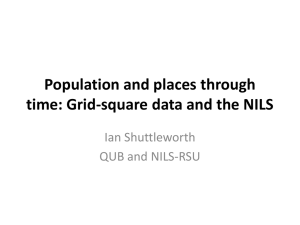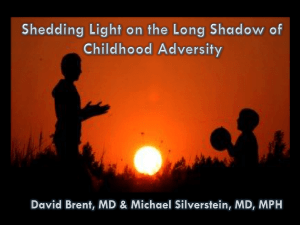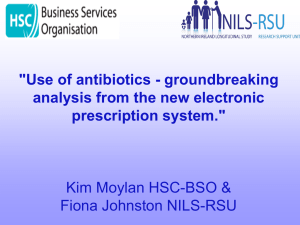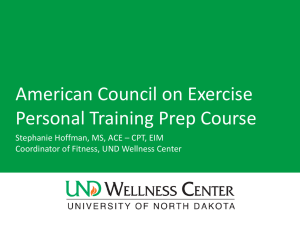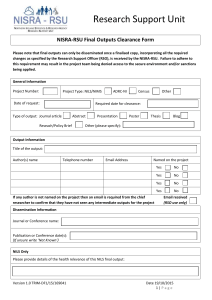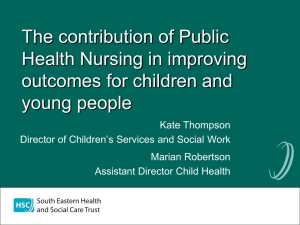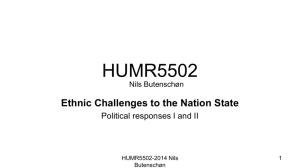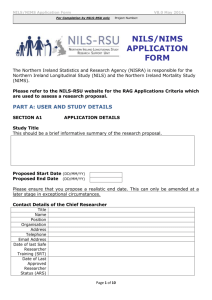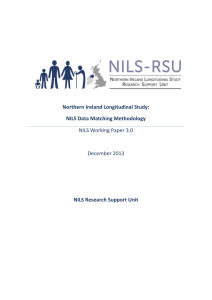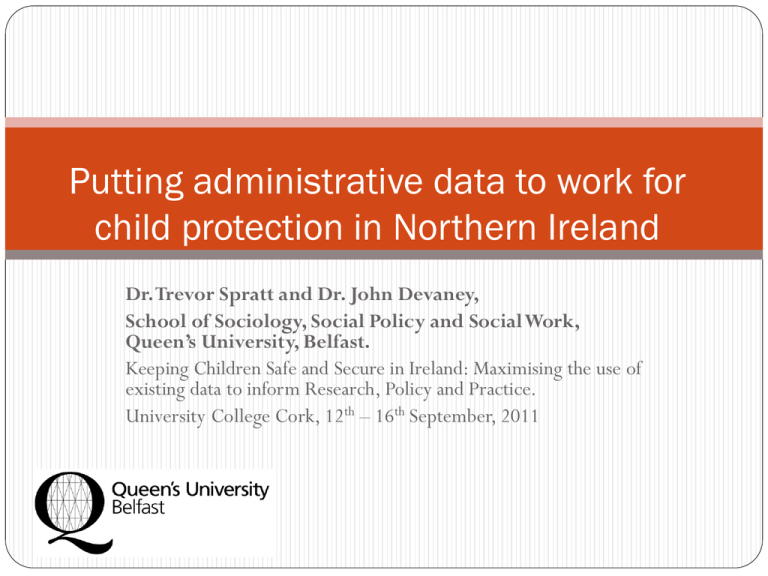
Putting administrative data to work for
child protection in Northern Ireland
Dr. Trevor Spratt and Dr. John Devaney,
School of Sociology, Social Policy and Social Work,
Queen’s University, Belfast.
Keeping Children Safe and Secure in Ireland: Maximising the use of
existing data to inform Research, Policy and Practice.
University College Cork, 12th – 16th September, 2011
Aims
To demonstrate how research questions are generated via
experience.
To demonstrate how research questions are generated by
developments in other fields.
To demonstrate how research instruments may be adapted for use.
To help you refine your own research question
To identify the data sets helpful in answering our research question
To describe the processes of linking such data sets
To identify key lessons learnt from such processes
To help you identify the types of data sets providing useful in
addressing your own research questions
Our first starting point - experience
Practice experience indicated that children in some
families were known to social workers for long
periods of time.
How might the needs of such children be best
conceptualise?
Present system built on fairly basic analysis of risk
factors – often with regard to incident and
frequency.
We might also question the current configuration of
child and family social work services – Looked After
Children, Child Protection and Family Support
Are there better ways to understand needs and
stimulate alternative service responses?
Our second starting point - Lessons from
Frank – father of emergency medicine
Frank Pantridge was a local Dr who was interested in how to
best help people who had suffered heart attacks
He designed the first portable defibrillator and in 1965
installed it in an ambulance
As a result many lives were saved
Obituary – ‘It was only after the usual 10-15 years of
scepticism that a defibrillator was fitted in every ambulance
in the UK’
Comparisons with Henry – father of
emergency social work
Henry Kempe is associated with the rediscovery of child
abuse
The battered-child syndrome 1962
Design of an interventionist child protection system
Not as successful as Frank because of debate over which
cases require intervention
Beyond Frank
Deaths from heart attacks have fallen by 40% in the UK since the
early 1970s
Researchers conclude that 58% of the mortality decline is
attributable to reductions in major risk factors, for example,
smoking
Risk factors are identified by epidemiological evidence
(associations between smoking and heart attacks)
Reductions are achieved by public health programmes aimed at
behavioural change
Beyond Henry?
Less children may be dying as a result of child abuse but
many experience poor outcomes
The common risk factors have been identified – these include
the mental illness, substance abuse and domestic violence
Social Workers have encountered difficulties in responding to
the needs of this wider population, concentrating instead on
incident led interventions.
We need to move to a system that offers services to help
prevent poor outcomes for children made on an analysis of
risk factors and provision of services at an earlier stage
alongside an ‘emergency’ response system.
And yet..........
Risk still drives the system rather than support
Hayes, D. and Spratt, T. (2009) Child Welfare Interventions: Patterns of social work practice.
British Journal of SocialWork , 39, 1575-1597
Practitioners struggle to make a difference with
families with certain types of problems
Spratt, T. and Devaney, J. (2009) Identifying Families with Multiple Problems: Perspectives of
Practitioners and Managers in Three Nations. British Journal of SocialWork , 39, 418-434
The focus on outcomes is still underdeveloped
Davidson, G., Devaney, J. and Spratt, T. (2010) The impact of adversity in childhood on
outcomes in adulthood: research lessons and limitations. Journal of SocialWork, 10, 369-390
Borrowing method - Links have been made between
multiple adverse experiences in childhood and poor
outcomes in adult life
Research on adult populations suggests that many adult problems
have antecedents in childhood
Adverse Childhood Experiences (ACEs): experience of physical,
sexual or psychological abuse, violence perpetrated against the
mother, living in a household where there are substance abusers
or mentally ill care-givers and having a parent imprisoned.
Anda and Felitti (2006) found a strong graded relationship
between exposure to ACEs and the development of adult
diseases, including heart disease, cancer and liver disease.
Other ways of seeing the issues: The Effect of Adverse
Childhood Experiences on Adult Outcomes
The ACE study
http://www.acestudy.org
Recurrent
physical abuse
Recurrent
emotional abuse
Contact
sexual abuse
An
alcohol and/or drug abuser in the
household
An
incarcerated household member
Someone who is chronically
depressed, mentally ill, institutionalised
or suicidal
Mother is treated violently
One or no parents
Emotional or physical neglect
What’s My ACE Score?
Prior to your 18th birthday:
1. Did a parent or other adult in the household often or very often…
Swear at you, insult you, put you down, or humiliate you?
or
Act in a way that made you afraid that you might be physically hurt?
Yes No
If yes enter 1
2. Did a parent or other adult in the household often or very often…
Push, grab, slap, or throw something at you?
or
Ever hit you so hard that you had marks or were injured?
Yes No
If yes enter 1
3. Did an adult or person at least 5 years older than you ever…
Touch or fondle you or have you touch their body in a sexual way?
or
Attempt or actually have oral, anal, or vaginal intercourse with you?
Yes No
If yes enter 1
What’s My ACE Score?
4. Did you often or very often feel that …
No one in your family loved you or thought
you were important or special?
or
Your family didn’t look out for each other, feel close to each other, or support each
other?
Yes No
If yes enter 1
5. Did you often or very often feel that …
You didn’t have enough to eat, had to wear dirty clothes, and had no one
you?
to protect
or
Your parents were too drunk or high to take care of you or take you to the doctor if you
needed it?
Yes No
If yes enter 1
6. Was a biological parent ever lost to you through divorced, abandonment, or other
reason ?
Yes No
If yes enter 1
What’s My ACE Score?
7. Was your mother or stepmother:
Often or very often pushed, grabbed, slapped, or had something thrown at her?
or
Sometimes, often, or very often kicked, bitten, hit with a fist, or hit with something hard?
or
Ever repeatedly hit over at least a few minutes or threatened with a gun or knife?
Yes No
If yes enter 1
8. Did you live with anyone who was a problem drinker or alcoholic or who used street drugs?
Yes No
If yes enter 1
9. Was a household member depressed or mentally ill or did a household member attempt suicide?
Yes No
If yes enter 1
10. Did a household member go to prison?
Yes No
Now add up your “Yes” answers: _______ This is your ACE Score
If yes enter 1
Cumulative Effect of Adversity
Number of
Adverse
Childhood
Experiences
(ACE Score)
Women
Men
0
34.5%
38.0%
36.1% (36.1%)
1
24.5%
27.9%
26.0% (62.1%)
2
15.5%
16.4%
15.9% (78.0%)
3
10.3%
8.6%
9.5% (87.5%)
4 or more
15.2%
9.2%
12.5% (100%)
Total
The Effect of Adverse Childhood Experiences
on Adult Outcomes
Prevalence
ACE Scores vs Smoking
14
12
10
8
6
4
2
0
0
1
2
ACE Score
3
4 to 5
The Effect of Adverse Childhood Experiences
on Adult Outcomes
ACE Scores vs Adult Alcohol Dependence
Prevalence
20
15
10
5
0
0
1
2
ACE Score
3
4 or more
The Effect of Adverse Childhood Experiences
on Adult Outcomes
ACE Scores vs Parasuicide
Prevalence
20
15
10
5
0
0
1
2
ACE Score
3
4 or more
Refining our research question
Our intuition from professional experience suggested that there
were deeper processes at work shaping outcomes for children than
those measures privileged by the system would suggest.
Work in medicine demonstrated that reduction in risk factors at
earlier stages had impact on outcomes.
Research demonstrated previously unrecognised links between
experience of multiple adversity and later outcomes
Combining data sets suggested on possible solution to how we
might begin to identify families with children experiencing
multiple adversities
Questions
How might your own experience help inform your research
question?
What might be borrowed from other fields in terms of
conceptual development and methodology?
How might we approach the use of data sets in developing
answers to our own research questions – trawling (seeing
what comes up), or casting (purposeful fishing)?
Background to Current Study
Social problems are not evenly distributed across the
population. They cluster within certain communities, families
and individuals.
Poverty, for example, is strongly associated with lower
educational outcomes, alcohol and drug use, unemployment,
poorer health, etc.
Children from the 5% of the most disadvantaged households are
more than 100 times more likely to have multiple problems at
age 15yrs than those from the 50% of most advantaged
households
High levels of intergenerational continuity of social problems
experienced in childhood
Background to Current Study
“Need” can be observed at the individual level (social work
assessment) and the population level (epidemiology)
Complex interaction between need, demand and supply at
individual, family and community levels
Three main ways of assessing need at the population level:
- Official client records (hidden/unmet need).
- Social surveys (response rates; measurement error)
- Proxy indicators (wide range of methodological
weaknesses)
Background to Current Study
Require research studies that can:
assess long-term outcomes for children
study rare events
utilise quality data
assess the impact of policy change
provide real-time answers
provide answers at different levels of analysis
contextualise and triangulate (multiple data sets)
Need for multi-sector longitudinal
administrative datasets
(Jonson-Reid & Drake, 2008)
Study aim
To assess the feasibility of constructing a longitudinal database
of families and children through combining data from the
CENSUS (NILS) with social services administrative data
(SOSCARE)
Funded by ESRC and Public Health Agency (NI)
Objectives are to assess:
Practicability of combining the datasets
Accuracy and quality of the data
Applicability of combined dataset to addressing questions on long-
term multiple and complex needs
The datasets
Northern Ireland Longitudinal Study
An anonymous sample (28%) of census returns from the NI
population (similar datasets in England & Wales and Scotland)
Around 500,000 individuals included within the NILS dataset
Census information includes demographic, socio-economic,
self-reported health, housing, household and family structure
data
Information is available on the selected individual AND their
household
Census information is also linked to other VITAL STATISTICS
(births; deaths; migration; area information)
Given the sensitivity of the data, analysis is undertaken within a
secure setting, and is subject to increased scrutiny and
heightened ethical and privacy protection protocols
The datasets
SOSCARE
Main social services administrative dataset for recording client
contact in Northern Ireland:
Unique source of data on services to children within UK
Universal
Contains data on clients (demographic and assessment data)
and activity (services received)
While it does have limitations, efforts have been made to
substantially improve quality
Variables
SOSCARE
NILS
i. Demographic Details
- name
- date of birth
- address
- other family members
ii. Service Usage
dates of referral
services being provided
name of staff involved
date of termination of service
iii. Fulfilment of Statutory Requirements
dates of legal and case reviews
legal orders applied for and granted
completion of statutory assessments
changes of placement for children
looked after
iv. Financial Payments
- financial payments to individuals
- financial payments to foster carer
2001 Census data for NILS members including
data on:
- Age, sex and marital status, Health & Care number
- Family, household or communal establishment type
- Housing, including tenure
- Country of birth
- Educational qualifications
- Economic activity
- Occupation and social class
- Long-standing illness/Self-rated health
- Religion
- Care giving
2001 Census data for those living in the same
household as a NILS member
This provides contextual information about the
household circumstances of NILS members
Vital Events (GRO Data)
- New births into the sample
- Births to sample mothers
- Stillbirths to sample mothers
- Infant mortality of children of sample mothers
- Deaths of sample members
Valuations and Lands Agency (VLA) Data
Advantages of this work
Both NILS and SOCARE are longitudinal datasets (tracking
families over time) allowing us to examine long term outcomes
(1991, 2001 and 2011 census)
Large sample size
SOSCARE is relatively non-reactive
SOSCARE provides details of clinical assessment and service
utilisation
Census has higher response rates amongst hard to reach
populations than other social surveys
NILS can track rare critical incidents (i.e. child fatalities).
Provides details of family characteristics from multiple sources.
Should permit individual and areal level analysis
Should permit assessment of regional policy change
Profiling and Comparing Populations
A1: proportion and profile of
children known to SOSCARE
and NILS
Children and
families known
to NILS
B
Children and
families in
deprivation
A1
A2
C
Children and
families
known to
SOSCARE
Note:
1. Circles are not to scale
2. Both datasets contribute cases
A2: proportion and profile of
children known to SOSCARE
and NILS who also live in
deprivation
B: proportion and profile of
children living in deprivation
and are known to NILS but
NOT to SOSCARE
C: proportion and profile of
children living in deprivation
and are known to SOSCARE
but NOT to NILS
Progress
Methodological Issues
Legal Issues
Ethical Issues
Technical Issues
SOSCARE
Personal
Identifiers
Selected
Variables
Removed
Selected
Variables
Northern Ireland Longitudinal Study (NILS)
Health &
Care
Number
Health &
Care
Number
One way
encryption
One way
encryption
xyzb
xyzb
Matching
Selected
Variables
xyzb
removed
New Dataset
Selected
Variables
Selected
Variables
Personal
Identifiers
Removed
Selected
Variables
Thoughts on the project so far
Think of a number, any number, double it, add 10........
Legal issues involved in health data in UK
Ethical issues surround administrative data sets are
considerable and complex.
Planning secondary analysis without the data in front of you
is a challenge.
Operational definitions are crucial (e.g. Differences
between a family and a household)
Data management issues are considerable (e.g. movers,
clustering)
Standard challenges of secondary analysis all apply
Research and technical support is essential



